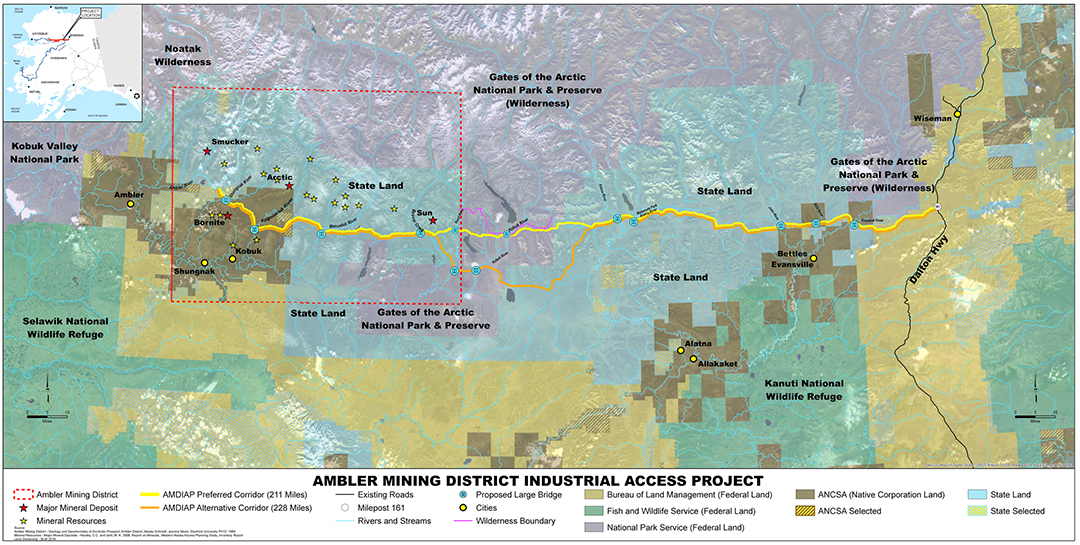UPDATE
Opponents of the controversial road construction project do not simply accept the federal government’s decision and filed a lawsuit in the US District Court for Alaska on Tuesday. The Northern Alaska Environment Center and another eight environmental groups write in their lawsuit that federal agencies failed to comply with several laws advancing the project, including the Clean Water Act, the Alaska National Interest Lands Conservation Act and the National Environment Policy Act, and that the decision to approve the road was taken on the basis of a deeply erroneous and inadequate environmental assessment. The defendants include the Office of Land Management, the Department of the Interior, the National Park Service, the Army Corps of Engineers and the US Coast Guard.

Northwest Alaska is rich in mineral resources — especially copper, zinc, lead, cobalt, silver, and gold are found in the region in worthwhile quantities. Now the isolated Ambler mining area is to be developed and made commercially viable. The construction of the highly controversial connecting road was approved by the US federal government on 23 July.
More than four million tons of copper, 1.6 million tons of zinc, 285,000 tons of lead and 22,000 kilograms of gold are expected to rest in the Ambler Mining District. The future mining products are to be transported to the Dalton Highway via the planned 340 kilometer Ambler Road.
The road would pass through ecologically important areas along the southern foothills of the Brooks Range and parts of the Gates of the Arctic National Park, which is why native American tribal governments living along the proposed road vehemently oppose road construction. They see the West Arctic caribou herd, the largest on the continent with 235,000 animals, and other natural resources under threat. Some critics also question the economic and fiscal solidity of the state’s involvement in the project, arguing that the state should not spend money to support private companies in this way.

The Alaska Industrial Development and Export Authority (AIDEA) is sponsoring the 2020 work program, which is worth $500,000, and is pushing for the preparatory work to be carried out.
However, Ambler Metals LLC., a partnership between Trilogy Metals Inc. (Canada) and South32 (Australia), which will provide the other half of the nearly million-dollar project, canceled the fieldwork for this summer due to the coronavirus pandemic. According to Trilogy, the postponement of the field work will not significantly affect the development of the mining operations.
AIDEA’s 500,000 U.S. dollars come from its Arctic Infrastructure Fund. As recently as April, the agency shifted $35 million into this fund, primarily to finance the Ambler Road as a key project. The decision for sponsorship was unanimous in AIDEA’s committee, but the public comments in advance were highly controversial.
Kati Capozzi, president of the Alaska Chamber of Commerce, supports the road construction: “The most important thing is that the project will create new jobs for Alaskans. There is no more important time than now to identify new employment opportunities […].”
Equally positive is Casey Hammond, the deputy secretary for land and minerals management. He said: “President Trump has long recognized why infrastructure investment is vital to meet the urgent need for critical minerals. The Trump Administration’s success today is a game changer for our nation’s ability to secure American prosperity and national security.”
This is countered by vehement protests by tribal governments and environmental groups. Alex Johnson, Alaska’s program manager for the National Parks Conservation Association, strongly opposes the construction, saying that AIDEA has made “wildly optimistic projections about benefits to Alaskans” and that those predictions were unfounded. These forecasts include estimates of the jobs to be created with the summer construction work, Johnson said. “Rather than spending that money on an industry pipe dream, I encourage AIDEA to spend it on Alaskan businesses who need it right now.”
Solaris Gillispie, the manager of clean water and mining for the Northern Alaska Environmental Center, finds it alarming that the state is willing to spend public money on a private project that clearly does not serve the public interest. “As the communities in the region have stated again and again: the impacts to the regionʼs water, food, and cultural sovereignty are unacceptable. Alaska’s wealth is in our lands, waters, and people, and we will not allow the state to trade that wealth for multinational companies’ profit.”
In addition, Doyon, the Alaska Native regional corporation that owns large swathes of the land in the Alaska Interior region, has not yet given the green light for the crossing of their land. “Doyon knows that the record of decision will be issued today, but there is still a lot of work to be done before there is an agreement for access to Doyon’s land”, said Aaron Schutt, the corporation’s president, last Thursday.
Typically, it would be almost impossible to obtain a permit for an industrial road through a national park. But Congress included a provision in the 1980 Alaska National Interest Lands Conservation Act allowing the crossing of the Gates of the Arctic National Park, as the vast mineral deposits in the Ambler region were already known back then.
Julia Hager, PolarJournal





